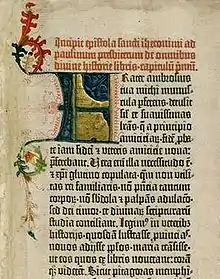Witchcraft and divination in the Hebrew Bible
Various forms of witchcraft and divination are mentioned in the Hebrew Bible (Tanakh or Old Testament), generally (but not always) in a disapproving tone.
_2.jpg.webp)
Hebrew Bible
The Torah assigns the death penalty to practitioners of certain forms of witchcraft and divination; the Holiness Code of Leviticus ascribes the death penalty for two of the three necromantic practices, namely Ba'al ob and Yidde'oni,[1] while the Covenant Code of Exodus ascribes it for kashaph.[2]
According to Ann Jeffers, necromancy was practiced throughout Israel's history, as evidenced by the presence of laws forbidding it.[3]
The Masoretic Text forbids:
- nahash;[4][5] as a noun, nahash translates as snake, and as a verb it literally translates as hissing. The verb form can be extended to mean whispering.
- onan;[4][5] onan literally translates as clouds, possibly referring to nephomancy.
- kashaph;[5][2] kashaph is of ambiguous meaning, being either from a root meaning mutter,[6] or from a compound of the words kash (herb) and hapalah (using) - hence meaning herb user.[7] The Septuagint renders the same phrase as pharmakia (poison).[8]
- being a ba'al ob;[1][9] ba'al ob literally means master of spirits. The corresponding parts of the Septuagint refer to eggastrimuthos. (gastromancy).[10] This term is also used to describe the Witch of Endor, whom Saul enlists to summon the shade of Samuel in 1 Samuel 28
- being a yidde'oni;[1][9] yidde'oni literally means gainer of information from ghosts
- being a doresh el ha-metim;[9] doresh el ha-metim literally means (one who) questions corpses
- qasam qesem;[5] qasam qesem literally means distributes distributions.
- khabar kheber;[5] khabar kheber literally means join joinings.
Specific verses
- Micah 5:12 expresses that witchcraft, as specified, will be eliminated among those of Israel.
- Exodus 22:18 in the King James Version says "Thou shalt not suffer a witch to live".[2]
- Deuteronomy 33:8-10 refers to the Levites' use of the Urim and Thummim and various forms of sacrifice as instruments of divination to determine guilt and innocence in law cases.[11]
- The silver chalice that is placed in Benjamin's sack when he leaves Egypt is described as being used by Joseph for divination, which is often taken as a reference to its use for scrying.[12][13]
- Numbers 5:11-31 describes a practice of making a wife who has been accused of adultery drink a mixture of water and dust from the floor of the Tabernacle in order to prove her guilt or innocence.[14]
- 1 Samuel 28: Saul enlists a woman to summon the spirit of the deceased prophet Samuel
Description
Many of these condemnations come from Deuteronomy 18:9-14 which is the only part of the Hebrew Bible referring to legal precepts which portrays these forms of divination as of foreign origin. Leviticus makes no such claim.[15]
The exact difference between the three forbidden forms of necromancy is a matter of uncertainty; yidde'oni is always used together with ob,[16] and its semantic similarity to doresh el ha-metim raises the question of why all three are mentioned in the same verse of Deuteronomy.[17] Rashi describes the doresh el ha-metim as a person who would sleep in cemeteries, after having starved themselves, in order to become possessed.
See also
Notes and references
- Leviticus 20:27
- Exodus 22:18
- Magic and Divination in Ancient Palestine and Syria, Ann Jeffers, BRILL, 1996, pg 181
- Leviticus 19:26
- Deuteronomy 18:10–11
- Strong's concordance
- Webster's New World Hebrew Dictionary
- Exodus 22:18 (LXX);
- Deuteronomy 18:11
- Leviticus 20:27 (LXX)
- Magic and Divination in Ancient Palestine and Syria, Ann Jeffers, BRILL, 1996, pg 62
- http://www.religioustolerance.org/divin_bibl.htm
- Crystal-Gazing, Theodore Besterman, Cosimo, Inc., 1 Jan 2005, pg 73
- The Lost Art of Enochian Magic: Angels, Invocations, and the Secrets Revealed to Dr. John Dee, John DeSalvo, Inner Traditions / Bear & Co, 14 May 2010, pg 24
- Divination in Ancient Israel and its Near Eastern Environment: A Socio-Historical Investigation, Frederick H. Cryer, A&C Black, 1 May 1994, pg 231, 232
- Magic and Divination in Ancient Palestine and Syria, Ann Jeffers, BRILL, 1996, pg 172
- specifically, Deuteronomy 18:11
